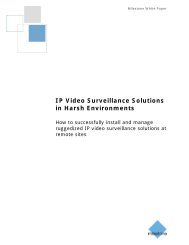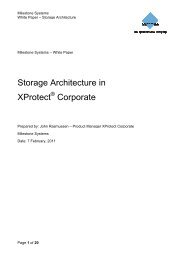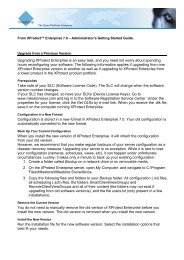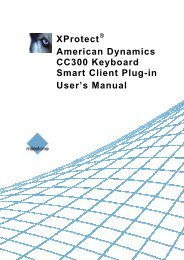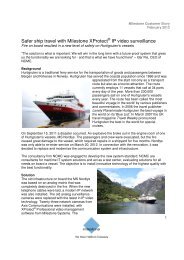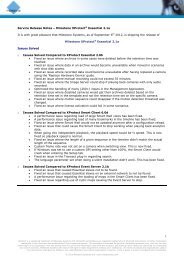XProtect Express 1.1; Administrator's Manual - Milestone
XProtect Express 1.1; Administrator's Manual - Milestone
XProtect Express 1.1; Administrator's Manual - Milestone
Create successful ePaper yourself
Turn your PDF publications into a flip-book with our unique Google optimized e-Paper software.
<strong>Milestone</strong> <strong>XProtect</strong> ® <strong>Express</strong> <strong>1.1</strong><strong>Administrator's</strong> <strong>Manual</strong>Storage capacity required for archivingThe storage capacity required for archiving depends entirely on the amount of recordings you plan to keep, andon how long you want to keep them (retention time). Some organizations want to keep archived recordings from alarge number of cameras for several months or years. Other organizations may only want to archive recordingsfrom one or two cameras, and they may want to keep their archives for much shorter periods of time.You should always first consider the storage capacity of the local drive containing the default archiving directoryto which archived recordings are always moved, even though they may immediately after be moved to anarchiving location on another drive. Basically, the capacity of the local drive should be at least twice the sizerequired for storing the databases of all cameras.When you archive, <strong>XProtect</strong> <strong>Express</strong> automatically checks that space required for the data to be archived plus 1GB of free disk space per camera is available at the archiving location. If not, the archive location's oldest datafrom the camera in question will be deleted until there is sufficient free space for the new data to be archived.When you estimate storage capacity required for archiving, consider your organization's needs, then plan forworst case rather than best case scenarios.Tip: The Storage Calculator, found in the Support section of the <strong>Milestone</strong> website, can help you determine thestorage capacity required for your surveillance system.About archiving schedulesThere are two ways in which to configure archiving schedules:While you configure your cameras through the Configure Video and Recording wizard (see "TheConfigure Video and Recording wizard" on page 57), in which case you configure your archivingschedule on the wizard's Drive selection page.As part of the general Scheduling and Archiving properties: In the Management Application's navigationpane, expand Advanced Configuration, right-click Scheduling and Archiving, select Properties,select Archiving in the dialog, and specify required properties.Automatic response if running out of disk spaceIf <strong>XProtect</strong> <strong>Express</strong> runs of disk space while archiving, you can set up an automatic response. Two scenarios canoccur, depending on whether the camera database drive is different from, or identical to, the archiving drive:Different drives: Automatic archiving if database drive runs out of disk spaceIn case the <strong>XProtect</strong> <strong>Express</strong> server is running out of disk space, and the archiving drive is different from thecamera database drive, and archiving has not taken place within the last hour, archiving will automatically begin inan attempt to free up disk space. This will happen regardless of any archiving schedules. The server isconsidered to be running out of disk space if:there is less than 10% disk space left, and the available disk space goes below 30 GB plus 1.5 GB percamerathe available disk space goes below 150 MB plus 20 MB per camera (example: with ten cameras, theserver would be running out of disk space if the remaining available disk space went below 350 MB (150MB plus 20 MB for each of the ten cameras))The difference ensures that very large disks will not necessarily be considered to be running out of disk space justbecause they have less than 10% disk space left.On the archiving drive, <strong>XProtect</strong> <strong>Express</strong> automatically checks that the space required for data from a camera tobe archived plus 1 GB of free disk space per camera is available. If not, the archive drive's oldest data from thecamera in question will be deleted until there is sufficient free space for the new data to be archived.IMPORTANT: You will lose the archive data being deleted.www.milestonesys.com 121 Advanced configuration



